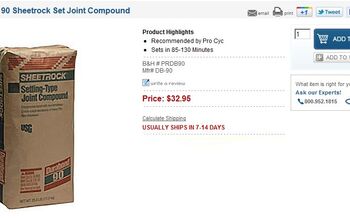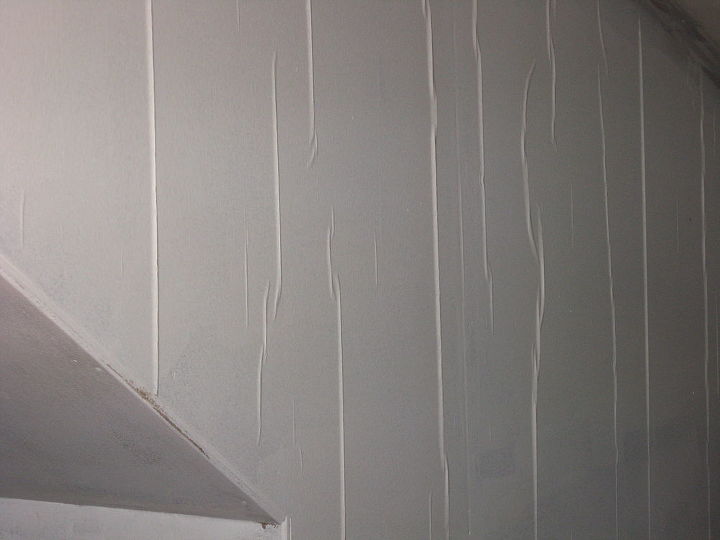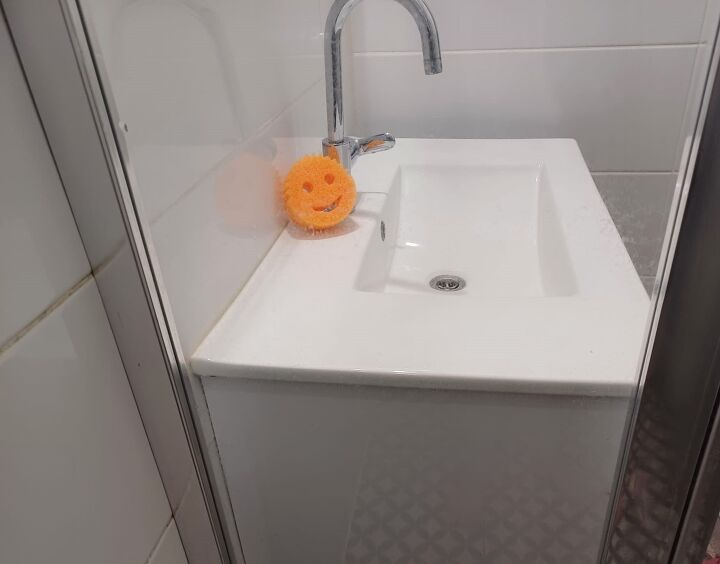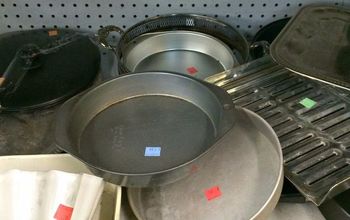Help!

-
Looks like the paper covering the can't handle the paint. You said there was paper covering drywall. If it is wall paper, it should be removed. Try a steamer and scraper. Sometimes you can sand down the bubbles spackle and repaint, but yours looks kinda severe for that.
 James A
on Aug 22, 2011
Helpful Reply
James A
on Aug 22, 2011
Helpful Reply -
-
I wish it was wallpaper! It is just old drywall made to look like wood. (I didn't want anyone to get confused looking at the before picture). It does look pretty severe, doesn't it? I think your suggestion might be my only option though, short of replacing the walls.
 Kelley M
on Aug 22, 2011
Helpful Reply
Kelley M
on Aug 22, 2011
Helpful Reply -
-
You should check to see if there might be wall paneling under the wallpaper. I don't think you would have gotten so much bubbling with the regular wall. In any case, looks like you have to do a lot of scraping. Good look.
Donna J on Aug 22, 2011
Helpful Reply -
-
That looks like the water in the latex paint caused the blisters..I'm surprised you did not see some of this effect when you used the damp sponge? How long after wiping with the sponge before you painted? If that time frame was short...then is could have been a combined effect. To fix this you will need to scrap these bubble off...using a sharp drywall type knife...the "hole" will then need to be filled with drywall mud...sanded etc. This does appear to be some type of paper that was added to the drywall...the paper of the drywall would not react to paint this way. If the scraping does not work easily a steamer may be needed to remove this "paper"
 KMS Woodworks
on Aug 22, 2011
Helpful Reply
KMS Woodworks
on Aug 22, 2011
Helpful Reply -
-
Kelley, For best results, get rid of the paper. If it's wallpaper, there are a variety of paper strippers on the market you can try. Or a wallpaper steamer might work. Otherwise, thoroughly soak it with hot water (as hot as you can stand, without fear of burning yourself of course). Use a sponge to apply the water. Use a LOT of water. When you think to yourself, "Wow, I used a lot of water," apply more water. Keep the area you are working very wet. You can use a little tool called a Wallpaper Tiger (made by Zinsser) to score up the paper and allow the stripper/water to penetrate to the glue behind. Note though that this will also score up the drywall and it will need to be patched up. Peal the paper away as much as you can and use a putty knife for the rest. Use drywall joint compound the skim smooth any damage to the wall. Then after the wall is even and smooth, sand, prime and paint. Good luck, let us know how it works out.
 Dan's of Central Florida, Inc.
on Aug 22, 2011
Helpful Reply
Dan's of Central Florida, Inc.
on Aug 22, 2011
Helpful Reply -
-
There was a day in between cleaning and priming and the sponge was not very wet. It didn't bubble up until after it was primed. I think scraping and repairing is my only option - not looking forward to it, but hopefully the end result will be worth it! If the wood-looking paper on the drywall is removed, it is fuzzy like it would be under drywall so I'm not sure if it could be steamed off. I am thinking it is the original drywall and the house was built over 50 years ago. Now my question is, can I paint oil primer over the latex primer I've already put on? I don't want to risk it bubbling up again.
 Kelley M
on Aug 22, 2011
Helpful Reply
Kelley M
on Aug 22, 2011
Helpful Reply -
-
Dan - didn't see your post before I posted. Can I take off the paper even if it is brown and fuzzy underneath? I am going to try to patch it up first because I feel that would be easiest. If that doesn't work, I'll try to remove paper then might have to skim coat the wall. Hopefully I will have some beautiful after pictures in a couple days...I can dream, right?
 Kelley M
on Aug 22, 2011
Helpful Reply
Kelley M
on Aug 22, 2011
Helpful Reply -
-
The fuzzy layer that you see is probably the backing of the wallpaper. That will need to come off as well. If this layer is already failing, don't try to skim it with sheet rock mud until all of it is removed. That is also water based and will continue to saturate into it. As it dries, it shrinks and the problem will just continue.
 WallsTreat Studio/ Kass Wilson
on Aug 22, 2011
Helpful Reply
WallsTreat Studio/ Kass Wilson
on Aug 22, 2011
Helpful Reply -
-
Kelley, it's not as bad as it seems. What happened was the components in latex primers act like a stripper to these unsealed paper products and make them start to delaminate or bubble off. When priming these papery products, always use an oil-base primer, like the original Kilz and you won't have any problem, except dealing with the fumes. With this first wall you primed, take a razor blade and cut out the bubbles then prime the entire wall with oil-base primer and skim the bubble scars with joint compound. At that point any primer or finish is good. I'm glad you just had one test wall! Best, Charles
 Peace Painting Co., Inc.
on Aug 22, 2011
Helpful Reply
Peace Painting Co., Inc.
on Aug 22, 2011
Helpful Reply -
-
There is something in the faux wood coloring that is causing a reaction. I would try some kilz oil based primer sealer. But before you paint the whole wall do a small test area to make sure that you won't have a similar problem. How to deal with what you have now? I'm not really sure. Well I see Peace Painting beat me to it. It looks like you got your answer twice and your solution once. Good luck!!!
 Paul M
on Aug 22, 2011
Helpful Reply
Paul M
on Aug 22, 2011
Helpful Reply -
-
Thanks everyone - guess I had to learn the hard way! To think I had a can of oil based primer sitting right there. I picked the wrong one, trying to avoid the fumes. And if only it was one wall...there are actually two more walls, but it is a small room with a large window so maybe it won't be too bad. I didn't realize it was happening until it was too late. Hopefully I'll have the patience to deal with it this week. Once again, thanks for all the help! I'll try a post a prettier "after" picture later on!
 Kelley M
on Aug 22, 2011
Helpful Reply
Kelley M
on Aug 22, 2011
Helpful Reply -
-
Peace Painting hit the nail on the head by my experience. Cut,prime, spackle, prime the spackle after drying to keep from "flashing" and repaint. You should be just fine...Let us know how it works! B2U JL
 JL Spring & Associates
on Aug 22, 2011
Helpful Reply
JL Spring & Associates
on Aug 22, 2011
Helpful Reply -
-
Remove the contact paper first. then skim coat and paint
 Nichter's Home Services Corp
on Aug 22, 2011
Helpful Reply
Nichter's Home Services Corp
on Aug 22, 2011
Helpful Reply -
-
Using a "hot mix" drywall compound ...the setting type rather than the drying type could save you a few days...it is a dry mix that water is added to..then used...is sets up a bit like plaster of Paris...sand and prime like normal
 KMS Woodworks
on Aug 23, 2011
Helpful Reply
KMS Woodworks
on Aug 23, 2011
Helpful Reply -
-
I like the Durabond 90 Kevin, sandable in no time paintable same day easy! JL
 JL Spring & Associates
on Aug 23, 2011
JL Spring & Associates
on Aug 23, 2011
 Helpful Reply
Helpful Reply -
-
Jerry I have used that and the Easy sand 90...I prefer the lighter texture of the easy sand
 KMS Woodworks
on Aug 24, 2011
Helpful Reply
KMS Woodworks
on Aug 24, 2011
Helpful Reply -
-
You're right K, I really dislike that darn dust Too!
 JL Spring & Associates
on Aug 24, 2011
Helpful Reply
JL Spring & Associates
on Aug 24, 2011
Helpful Reply -
-
Porter Cable makes a very good vacuum sander/shop vac.
 Peace Painting Co., Inc.
on Aug 25, 2011
Helpful Reply
Peace Painting Co., Inc.
on Aug 25, 2011
Helpful Reply -
-
I use a screen sander that hooks up to my regular shop vac....it works like a charm...you need to use "bags" inside the shop vac or the filters will clog quickly.
 KMS Woodworks
on Aug 25, 2011
Helpful Reply
KMS Woodworks
on Aug 25, 2011
Helpful Reply -
-
Right Arm!:)
 JL Spring & Associates
on Aug 25, 2011
Helpful Reply
JL Spring & Associates
on Aug 25, 2011
Helpful Reply -
Related Discussions
How do I clean salt marks on my salt water pool?
My salt water pool leaves white marks all around the pool I have tried everything to remove them with no luck. Can someone please help me????
If you could redo your master bathroom, what would you change?
Dreaming of a master bathroom remodel?Tell us: If you could change just one thing, what would it be?Your input could inspire others looking for master bathroom ideas ... See more
Hardwood Floors or Carpet in Bedroom: What's Your Preference?
Hey Hometalkers! We've got a cozy debate going on here: when it comes to bedroom flooring, do you lean towards the warmth of carpet or the timeless elegance of hardwo... See more
What can I do about wood smoke coming into my house?
I need help. My back door neighbor heats with a wood stove all winter. They are downhill from me. Almost all their smoke makes its way into my house, causing headache... See more
How to find out the value of antique furniture
My husband and I are looking to sell his grandmother's dining room set but, we have no idea what to ask for it. We could not find any markings as to who made it, all ... See more
How do I fix a broken metal hanging rod in my closet
I have a broken shelf hanging rod in my closet I tried gluing And taping it and nothing worked I need help and also the shelf is slightly bent






